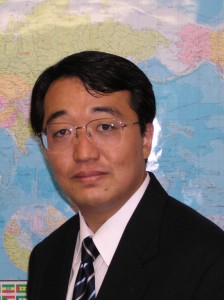緊張と統合:内村鑑三におけるキリスト教と日本の精神
このシリーズでは、私が1994年に執筆した統一神学大学院(Unification Theological Seminary)の神学課程修士論文(Divinity Thesis)を日英二か国語で掲載している。
今回から第6章の「無教会と日本社会」に入る。
6.無教会と日本社会
内村を巻き込んだ不敬事件は、彼が1891年に教育勅語に記された天皇の宸署の前で敬礼することを拒んだことによって引き起こされた。この事件はキリスト者の忠誠に関する国家的次元の論争にまで発展し、内村は東京の官営校の教師としての位置を退くことになった。実際、内村には明治天皇を冒涜するつもりなどなかった。彼はただキリスト者としての良心から、神以外のものに対して崇敬を払うのを躊躇しただけである。しかしこの事件は、国家宗教としての神道とキリスト教との対決の象徴的な始まりとなったのである。
ある意味で内村とキリスト教は、1889年から始まったナショナリズム復活の脈絡の中で、「スケープゴート」の役割を強いられたと言える。しかしもっと長い目をもって歴史を見てみれば、内村の言動は軍国主義への道を歩んで行ったその後の日本の歴史に対する偉大な警告であり、預言でもあったのである。この章においては、明治維新から1945年までの期間の脈絡において、内村の不敬事件の持つ意味を明らかにする。
A.明治時代の宗教的状況
1868年の維新の後、明治政府の主たる願望は西欧諸国との間に結んだ不平等条約の改訂を説得することであった。1865年10月23日に天皇が強制されて承認した条約は、1894年までの日本と西洋との関係の基礎を形成していた。これらの条約によって日本は、外国人の裁判権と関税自主権という二つの国家の基本権を奪われていた。それ故に日本人は開国以来国家が直面していた不利な立場を克服するために、躍起になって西洋の文化と技術を輸入しようとした。彼らは西洋的生活を、ほとんどあらゆる方面から借用したのである。
不平等条約の改訂を託された外交使節は、行った先々で日本は信教の自由を認めていないので非文明国であるとしか認めざるを得ないという非難を耳にした。この理由をもって西洋の諸国は条約の改訂を拒否して来た。このように西洋諸国の一致した圧力に説得されて、明治政府は1873年に基督教禁止令を撤廃したのである。宗教の自由は1889年に発布された憲法によって保証されていた。「日本臣民ハ安寧秩序ヲ妨ゲズ・及臣民タル義務ニ背カザル限リニ於テ信教ノ自由ヲ有ス」(第28条)このような状況下で膨大な数の宣教師が日本に殺到し、日本のキリスト教化は一般的な西欧化と相まって加速された。日本のプロテスタント教会は1872年から1889年にかけて全般的に拡大し、繁栄した。改宗者は急激に増え、未来の日本プロテスタント教会の大まかな輪郭は出来上がりつつあった。この17年間で、日本のキリスト教徒の人口は約3万人に成長した。成長して行く教会の行く手を阻む様な重大な障害はないかに見えた。
VI. Mukyokai and Japanese Society.
The Lese Majesty Incident (fukei jiken) which involved Uchimura was caused by his refusal in 1891 to bow before the Imperial signature affixed to the Imperial Rescript on Education (Kyoiku Chokugo). This led to a fierce nationwide controversy over the loyalty of Christians and to his resignation of his position as a teacher of the government academy in Tokyo. Actually Uchimura himself had no intention to blaspheme the Emperor Meiji; he just scrupulously hesitated as a Christian to pay homage to anything but God. This incident, however, became the symbolic beginning of the confrontation between Christianity and State Shinto as the national religion.
In a sense, Uchimura and Christianity were made to play the role of “scape-goat” in the context of resurgent nationalism which started from 1889. If we take a longer view of history, however, Uchimura’s speech and action could have been a great warning or prophesy to the subsequent Japanese history which headed for the path to militarism. The purpose of this chapter is to bring out the meaning of Uchimura’s Lese Majesty Incident in the context of the period from the Meiji Restoration to 1945.
A. Religious Situation of the Meiji Period.
Following the revolution of 1868, the primary wish of the Meiji government was to induce the nations of the Occident to revise the unequal treaties. The treaties which the emperor had approved under coercion on October 23, 1865, established the basis of Japan’s relations with the West until 1894. These instruments took away two of the nation’s rights: right of legal jurisdiction to foreign diplomats and tariff autonomy. Therefore, Japanese eagerly tried to import western culture and technocracy in order to overcome the disadvantage which confronted the nation after its reopening; they borrowed almost every phase of western life.(1)
The diplomatic mission charged with negotiating the revision of unequal treaties heard charges everywhere it went that because Japan did not provide for freedom of religious belief, it could only be considered an uncivilized nation. Citing this reason, Western nations refused to revise the treaties.(2)Thus the combined pressures of western nations persuaded the Meiji government to lift the edict banning Christianity in 1873. Religious freedom was guaranteed in the constitution of 1889: “Japanese subjects shall, within limits not prejudicial to peace and order, and not antagonistic to their duties as subjects, enjoy freedom of religious belief” (art. 28). In this situation, numerous missionaries rushed into Japan and Christianization of Japan was accelerated, accompanied by her general westernization. Protestantism in Japan generally expanded and prospered from 1872 to 1889; converts rapidly increased, and the main outlines of the future Protestant Christianity of Japan began to take form. During these 17 years, the population of Japanese Christians had grown to approximately thirty thousand.(3) No prominent obstacle of the growing church could be observed.(4)
(1)op cit, Thomas, p.185-6.
(2)Helen Hardacre, Shinto and the State, 1868-1988, (NJ: Princeton University Press, 1989), p.115.
(3)Arimichi Ebisawa and Saburo Ouchi, Nihon Kirisutokyou Shi [A History of Christianity in Japan], (Tokyo: Nihon Kirisuto Kyodan Shuppan Kyoku, 1971), p.194.
(4)op cit, Thomas, p.182.
